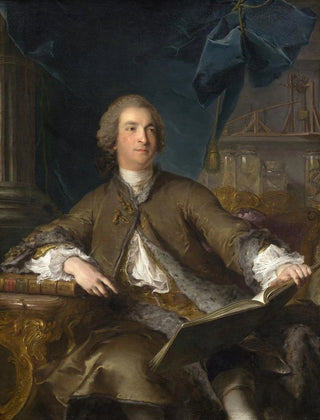Art print | Joseph Bonnier de la Mosson - Jean-Marc Nattier


View from behind

Frame (optional)
Reproduction Joseph Bonnier de la Mosson - Jean-Marc Nattier – Captivating Introduction
The work of Jean-Marc Nattier, titled "Joseph Bonnier de la Mosson," embodies an era when portraiture became a reflection of a rich social and cultural identity. This painting, both elegant and meaningful, immerses us in the refined universe of the 18th century, a period of rococo's peak. Through the delicate features of its subject, Nattier manages to capture not only Bonnier's physical appearance but also his status and character. This portrait is not merely a simple representation; it is a true invitation to explore the subtleties of a time when art and society intertwined intimately.
Style and uniqueness of the work
Nattier's style is distinguished by its lightness and finesse, characteristic of rococo. In "Joseph Bonnier de la Mosson," pastel colors and flowing drapes intertwine to create an atmosphere of softness and refinement. The choice of richly adorned clothing reflects a pronounced taste for elegance and fashion of the period. The pose of the subject, slightly turned to the left, suggests a certain introspection while maintaining a direct visual connection with the viewer. This portrait does not merely freeze a moment; it tells a story, that of a man of letters and sciences, whose penetrating gaze seems to address us, inviting us to discover the thoughts that animate him. Nattier's mastery of light and shadow further enhances the psychological depth of the character, making the work surprisingly modern.
The artist and his influence
Jean-Marc Nattier, an emblematic figure of the 18th century, established himself as one of the most sought-after portraitists of his time. Trained in his father's workshop, himself a painter, Nattier developed a unique style that combines realism and idealization. He captured the spirit of his era while drawing inspiration from past masters such as Rubens and Van Dyck. Nattier's influence is felt not only in his portraits of the nobility but also in the way he managed to give a voice to his subjects, the

Matte finish

View from behind

Frame (optional)
Reproduction Joseph Bonnier de la Mosson - Jean-Marc Nattier – Captivating Introduction
The work of Jean-Marc Nattier, titled "Joseph Bonnier de la Mosson," embodies an era when portraiture became a reflection of a rich social and cultural identity. This painting, both elegant and meaningful, immerses us in the refined universe of the 18th century, a period of rococo's peak. Through the delicate features of its subject, Nattier manages to capture not only Bonnier's physical appearance but also his status and character. This portrait is not merely a simple representation; it is a true invitation to explore the subtleties of a time when art and society intertwined intimately.
Style and uniqueness of the work
Nattier's style is distinguished by its lightness and finesse, characteristic of rococo. In "Joseph Bonnier de la Mosson," pastel colors and flowing drapes intertwine to create an atmosphere of softness and refinement. The choice of richly adorned clothing reflects a pronounced taste for elegance and fashion of the period. The pose of the subject, slightly turned to the left, suggests a certain introspection while maintaining a direct visual connection with the viewer. This portrait does not merely freeze a moment; it tells a story, that of a man of letters and sciences, whose penetrating gaze seems to address us, inviting us to discover the thoughts that animate him. Nattier's mastery of light and shadow further enhances the psychological depth of the character, making the work surprisingly modern.
The artist and his influence
Jean-Marc Nattier, an emblematic figure of the 18th century, established himself as one of the most sought-after portraitists of his time. Trained in his father's workshop, himself a painter, Nattier developed a unique style that combines realism and idealization. He captured the spirit of his era while drawing inspiration from past masters such as Rubens and Van Dyck. Nattier's influence is felt not only in his portraits of the nobility but also in the way he managed to give a voice to his subjects, the






